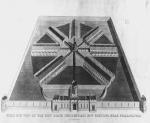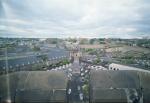![header=[Marker Text] body=[Original prison built 1822–1836 on a radial plan by John Haviland. Linking solitude with moral and vocational instruction, it exemplified the Pennsylvania System of penology and became a model for over 300 prisons worldwide. Closed 1971. ] sign](http://explorepahistory.com/kora/files/1/10/1-A-1C-139-ExplorePAHistory-a0a1l0-a_450.gif)
Mouse over for marker text
Name:
Eastern State Penitentiary
Region:
Philadelphia and its Countryside/Lehigh Valley
County:
Philadelphia
Marker Location:
2200 Fairmount Ave., Philadelphia
Dedication Date:
May 2, 1956
Behind the Marker
When Pennsylvania farmer Charles Williams crossed the cold stone threshold in 1829, his name became Prisoner Number One. What awaited the hooded man who followed the guard pulling his body into the unknown? His guess was as good as any other, for he was the first prisoner of Eastern State Penitentiary, a new prison established under progressive Quaker ideas of incarceration for a crime.
The forbidding castle-like structure sitting upon the Philadelphia hillside appeared to follow age-old notions of prison as a place of torture and physical punishment. But the new penitentiary was designed to reform the transgressor through inner reflection rather than punish him through imprisonment and physical pain.
The foundations for Eastern State had been laid in 1787, when a group of Philadelphians concerned with the overly harsh treatment and unsanitary conditions that they witnessed in the Pennsylvania Prisons organized the Philadelphia Society for Alleviating the Miseries of Public Prisons. Influenced by the Quaker emphasis upon the inherent goodness of man and the reforming power of a mind educated by moral principles, the gathered men envisioned a prison that would evoke penitence in criminals and thus turn them from their evil ways. Prominent Philadelphia physician Dr. Benjamin Rush encouraged their vision, stating his wish to see Pennsylvania become the standard in prison reform.
Dr. Benjamin Rush encouraged their vision, stating his wish to see Pennsylvania become the standard in prison reform.
After thirty years of petitioning, the Pennsylvania assembly agreed to test the Quaker's proposed penitentiary system. Design of the penitentiary was awarded to architect John Haviland, who based his plan upon the philosophies of Benjamin Rush and Quaker reformers. Haviland created a "forced monastery" that would isolate inmates and remove them from the evil influence of each other's company.
Alone and living in silence, prisoners were to contemplate on the spirit of God within what Quakers called the Inner Light and to reflect on what brought them to this place. Inside four massive stone walls, Haviland placed the cells along corridors that radiated out from the center like the spokes on a wheel. This would give the guards clear visibility into each cell, but block the inmates from viewing one another.
Each cell had its own skylight, in part to make inmates realize that their only means of healing came through the light of God, and an attached private yard in which the prisoner could spend one hour each day in sunlight and fresh air. Designed to reform rather than punish, the cells would have central heating, running water and a flush toilet; amenities that were still uncommon in the 1820s.
Haviland also called for thick interior walls to prevent illicit communication among inmates. The only sounds allowed in the penitentiary would be the word of God, flowing forth from the lips of a preacher as he walked down the aisles. Quakers contended that having prisoners live in "cellular isolation" would force them to face their actions. Through the word of God (the only item each inmate had with him was a Bible) and reflection on the Inner Light, true penitence would produce a change.
Once inside, prisoners would walk to and from their cells with black hoods covering their faces. There would be no visitors and no communication, except with oneself and with God. Quakers believed that silence and thinking were the keys to bring about the prisoners' moral reform.
Built on a farm overlooking the city of Philadelphia, the new penitentiary quickly ran over budget. At a cost of $800,000, Eastern State was one of the most expensive buildings in the United States when it opened!
Eastern State Penitentiary soon attracted worldwide attention and became an international model for modern penal reform. In the nineteenth century, more than 300 prisons across the globe mirrored Eastern's design. But while a visit to Eastern State became a regular stop for tourists visiting Philadelphia, questions soon emerged about the effectiveness of its techniques.
Did the Eastern State Penitentiary, indeed, produce penitence? In 1832 French diplomat Alexis de Tocqueville commended the system, agreeing with the Quakers that "it is in solitude, where remorse will come to assail him." Ten years later, the famous English author, Charles Dickens, penned strong disagreement. While acknowledging the good intentions of the Quaker reformers, he argued that "this slow and daily tampering with the mysteries of the brain [I hold] to be immeasurably worse than any torture of the body."
The reality of reformation of the inner self through isolation from evil influences never measured up to the ideal. In the succeeding years, the penitentiary moved away from its severe isolation techniques. Eventually a workshop, exercise yard and even a baseball league allowed more and more interactions among inmates.
By the early twentieth century, prisoners and law enforcement officials alike considered Eastern State one of the toughest prisons in the United States. Perhaps the most famous prisoner at the penitentiary was Al Capone. By the late 1960s the prison had grown old and outdated. Eastern State finally closed its doors in 1971. Quaker efforts to reform penal systems they find reprehensible, however, continue to the present day.
The forbidding castle-like structure sitting upon the Philadelphia hillside appeared to follow age-old notions of prison as a place of torture and physical punishment. But the new penitentiary was designed to reform the transgressor through inner reflection rather than punish him through imprisonment and physical pain.
The foundations for Eastern State had been laid in 1787, when a group of Philadelphians concerned with the overly harsh treatment and unsanitary conditions that they witnessed in the Pennsylvania Prisons organized the Philadelphia Society for Alleviating the Miseries of Public Prisons. Influenced by the Quaker emphasis upon the inherent goodness of man and the reforming power of a mind educated by moral principles, the gathered men envisioned a prison that would evoke penitence in criminals and thus turn them from their evil ways. Prominent Philadelphia physician
After thirty years of petitioning, the Pennsylvania assembly agreed to test the Quaker's proposed penitentiary system. Design of the penitentiary was awarded to architect John Haviland, who based his plan upon the philosophies of Benjamin Rush and Quaker reformers. Haviland created a "forced monastery" that would isolate inmates and remove them from the evil influence of each other's company.
Alone and living in silence, prisoners were to contemplate on the spirit of God within what Quakers called the Inner Light and to reflect on what brought them to this place. Inside four massive stone walls, Haviland placed the cells along corridors that radiated out from the center like the spokes on a wheel. This would give the guards clear visibility into each cell, but block the inmates from viewing one another.
Each cell had its own skylight, in part to make inmates realize that their only means of healing came through the light of God, and an attached private yard in which the prisoner could spend one hour each day in sunlight and fresh air. Designed to reform rather than punish, the cells would have central heating, running water and a flush toilet; amenities that were still uncommon in the 1820s.
Haviland also called for thick interior walls to prevent illicit communication among inmates. The only sounds allowed in the penitentiary would be the word of God, flowing forth from the lips of a preacher as he walked down the aisles. Quakers contended that having prisoners live in "cellular isolation" would force them to face their actions. Through the word of God (the only item each inmate had with him was a Bible) and reflection on the Inner Light, true penitence would produce a change.
Once inside, prisoners would walk to and from their cells with black hoods covering their faces. There would be no visitors and no communication, except with oneself and with God. Quakers believed that silence and thinking were the keys to bring about the prisoners' moral reform.
Built on a farm overlooking the city of Philadelphia, the new penitentiary quickly ran over budget. At a cost of $800,000, Eastern State was one of the most expensive buildings in the United States when it opened!
Eastern State Penitentiary soon attracted worldwide attention and became an international model for modern penal reform. In the nineteenth century, more than 300 prisons across the globe mirrored Eastern's design. But while a visit to Eastern State became a regular stop for tourists visiting Philadelphia, questions soon emerged about the effectiveness of its techniques.
Did the Eastern State Penitentiary, indeed, produce penitence? In 1832 French diplomat Alexis de Tocqueville commended the system, agreeing with the Quakers that "it is in solitude, where remorse will come to assail him." Ten years later, the famous English author, Charles Dickens, penned strong disagreement. While acknowledging the good intentions of the Quaker reformers, he argued that "this slow and daily tampering with the mysteries of the brain [I hold] to be immeasurably worse than any torture of the body."
The reality of reformation of the inner self through isolation from evil influences never measured up to the ideal. In the succeeding years, the penitentiary moved away from its severe isolation techniques. Eventually a workshop, exercise yard and even a baseball league allowed more and more interactions among inmates.
By the early twentieth century, prisoners and law enforcement officials alike considered Eastern State one of the toughest prisons in the United States. Perhaps the most famous prisoner at the penitentiary was Al Capone. By the late 1960s the prison had grown old and outdated. Eastern State finally closed its doors in 1971. Quaker efforts to reform penal systems they find reprehensible, however, continue to the present day.







